by Winding Pathways | Oct 25, 2018 | (Sub)Urban Homesteading, Flowers/Grasses, Garden/Yard, Garden/Yard, Nature, Reflections/Profiles
“It was amazing! Gorgeous! Fireflies danced over our prairie most of the summer, and they weren’t here when it was a mowed lawn,” said Katie Hill with much enthusiasm
She and her husband Tim are restoring an island of ecological health just three miles from downtown Cedar Rapids, Iowa. First Avenue is one of the busiest urban streets in Iowa, constantly filled with cars, motorcycles, and trucks. A bald eagle flying over the road would look down at an urbanized landscape – except for five acres of verdant beauty just a few feet east of the Avenue. The oasis is nestled between suburban developments, a high-rise condominium, and a senior residence complex.
Katie and Tim bought three and a half acres and a home about 15 years ago. It was convenient to his work at a law office a stone’s throw from their land. “We did the standard expected landscaping of mowing and spraying for about a decade,” she said.
Creating Habitat
Although the yard was large it lacked plant diversity and wildlife. Then came the change.
“We stopped spraying and I took delight when creeping Charlie and dandelions took hold. Many people don’t like them, but creeping Charlie has a gorgeous flower that bumblebees love, and it smells nice. Dandelions are beautiful, and bees love them,” she said. Then she broadcast prairie seed on a low area that had been lawn. After a couple of years big bluestem, Indian grass, and many native flowers appeared. Encouraged by their first prairie the Hill’s planted new ones in formerly mowed and sprayed lawns. They’ve been helped by David Novak, owner of a small company that helps people restore natural areas.
“We were delighted when lightning bugs appeared over the prairie. They don’t like mowed lawn but love taller plants. We watch them dance on summer evenings. These beautiful insects completely avoid the mowed lawns of our neighbors,” Tim and Katie remarked.
Early in 2018, the Hills bought about an acre and a half of land adjoining their property Years before several houses stood on the property but it had been purchased by a developer who planned to build two condominium towers. He razed the houses and built one condo tower but abandoned plans to build the second.
Restoring the Land
As we walked through the area Katie showed us her new prairie plantings in what had once been a lawn while Tim pointed out where the houses had stood. As the years go by the residents of the existing condominium tower will gaze downward during the day on wildflowers dancing in the breeze and butterflies sipping nectar from prairie blooms. As twilight approaches, they’ll enjoy fireflies blinking their tiny lights.
In addition to creating beauty and feeling the joy of making the earth healthier, the Hills are benefiting the community beyond their property. Prairie grasses absorb stormwater that once sheeted off their land and into storm sewers and eventually Cedar Lake. Their land nurtures wildlife as its beauty increases and diversifies.
“We feel good about what we are doing. We are helping nature restore itself in the heart of the city, but it also does one other thing. When we were mowing and spraying it was costing us about $600 a month to maintain the property. Now that’s dropped to about 90 bucks, so we’re saving money,” the Hills explained.
In the process of restoring their land, Tim and Katie Hill are also getting a fulfilling ecological education.
Win! Win! Win!
“It’s a win, win, win,” smiled Katie. “It’s a win for us saving money. It’s a win for us to have the time to be entertained by the wildlife diversity. And, most importantly, it’s a win for Mother Nature.”
-
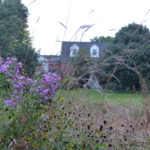
-
New England Asters grace the prairie.
-

-
Butterflies have flocked to the Hill’s property.
-

-
One of their many cats relaxes on the patio.
-
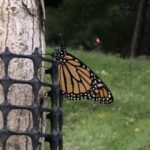
-
A Monarch perches in the lee of a tree resting before leaving for the south.
-

-
Owners of an urban oasis.
-
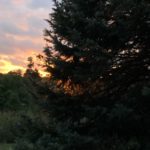
-
Beautiful sunset.
by Winding Pathways | Sep 20, 2018 | Chickens, Energy Efficiency, Flowers/Grasses, Garden/Yard, Garden/Yard, Nature
It’s turning time for wildlife, chickens, and people
As the Northern Hemisphere of the earth continues its ageless slow wobble away from the sun, days gradually shorten until a wondrous event happens.
The Autumnal Equinox happens around September 21st each year. It’s when daily hours of sunlight equal those of darkness. On only two days each year does every place on earth enjoy roughly 12 hours of sunshine. These are the fall and spring equinoxes. So, whether someone lives near the tropics or poles they will experience the same amount of light on only those two days.
Light changes quickly around equinox time. Up here in the Northern Hemisphere days shorten quickly and darkness advances until the December 21st Winter Solstice, the year’s darkest day. The Southern Hemisphere begins to enjoy its longest days through December.
Preparing
At Winding Pathways around the Equinox, we do these things:
- Stimulate our chickens. We plug in the timer and light bulb in the coop. Chickens lay the most eggs when there are about 15 hours of daylight. So, the coop light is set up to come on about 4:30 a.m. and turn off about three hours later when the sun pokes over the horizon.
- Drain, clean, and invert our rain barrels. We won’t need extra water until next spring, so we turn the barrels upside down, so they don’t collect winter water that freezes and can split the barrels. We weight them with stones to keep Arctic winds from blowing them away.
- Watch this short video on how to Prepare Rain Barrels
- Bring in pumpkins and winter squash. A frost is soon to come, and we don’t want it to bite our squash. We store
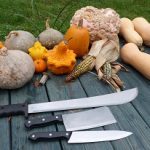
Winter Squash vary in color, texture, shape and size.
pumpkins and squash in a room we rarely use. It stays cool but above freezing. Butternut, Acorn, Hubbard, and most other winter squashes and pumpkins, which actually are a squash, keep for months and give us delicious and vitamin stoked food on cold days.
- Exclude, or try to, insects and mice. Somehow mice, box elder bugs and Asian beetles sense coming cold and find tiny cracks to enter the house and enjoy winter warmed by our furnace and wood stove. Each fall we caulk up cracks and weather strip doors to encourage them to stay outside where we prefer to see them. It’s never perfect. Some always find their way inside.
- Enjoy leaves. Each’s fall’s spectacular leaf color peaks in October but some leaves start turning sooner. Our backyard black walnut starts coloring up in early September. The real show is the deep orange, red, and yellows of our sugar maples. They peak in early to mid-October followed by russet oak leaves.
-
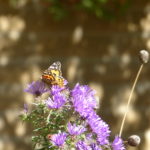
Fall wildflowers are an important food source for insects and birds.
Enjoy wildflowers. Asters, Goldenrods, and Maximilian Sunflowers are the very last blooms of the season. Their colors brighten the yard and provide nectar for insects and then seeds for migrating and overwintering birds. But all this comes with sadness as we know we’ll not see wildflowers again until next spring.
- Watch wildlife. It’s migration time and one of the best seasons for seeing unusual birds. We often look upward and sometimes spot pelicans and waterfowl winging high overhead. By now deer in their subdued winter coats are sleek and well fed on a diet of acorns. Bucks have polished their antlers. Chipmunks and squirrels scurry about caching winter food.
We’d like to hear what you enjoy about the Equinox time. Please email us your joys and projects in this wondrous season.
by Winding Pathways | Jul 26, 2018 | (Sub)Urban Homesteading, Birds, Bugs, Flowers/Grasses, Garden/Yard, Nature, Reflections/Profiles, Wonderment
The Gazette in Cedar Rapids has had several interesting nature stories connected to creating wondrous yards. Living Section features “Birds do it, Bees do it”, “Add a Little Luck to Your Landscape” and Purslane (by Winding Pathways). We loved reading about the birds and bees’ cooling strategies and welcomed the return of clover to yards as natural nitrogen fixers and deep-rooted water retention plants. And, of course, we love to eat purslane. Let us know ways you fix this healthy vegetable.
Also an article on wasps of late summer. They are beneficial, ‘though deserve keeping distance.
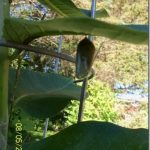
Success on the Bena Farm!
Best of all was the picture of the Monarch Chrysalis from friends, Nancy and Gordon Bena found on their farm. Let’s keep encouraging habitat for insects that form the basis of life for many other creatures.
by Winding Pathways | May 24, 2018 | (Sub)Urban Homesteading, Flowers/Grasses, Foraging, Garden/Yard, Garden/Yard, Weeds
Years ago, a homeowner visited a garden store and bought plugs of a plant commercially called ground ivy, but most folks today call it Creeping Charlie.
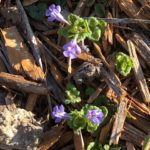
A great ground cover that can get away from you.
In many ways this exotic plant was an ideal ground cover. It’s tough, easy to transport and plant, adaptable to a wide range of conditions, needs no special care, and it spreads like crazy. It only grows a few inches tall so was touted as a plant that, once established, needs no maintenance. And, it attracts valuable pollinators early in the season before other flowering blooms appear.
Benefits
Creeping Charlie’s benefits are also its curse. It does everything too well. Creeping Charlie doesn’t creep. Rather, it races to cover a yard with astonishing speed, often crowding out more desirable plants.
There are two ways to view Creeping Charlie.
It’s either a pernicious pest or a friend that needs little care. At Winding Pathways, we look at it both ways depending on where it’s growing. When it’s crowding wildflowers or our garden vegetables we rip it out of the ground. In places where it can’t infect a garden or native wildflowers we leave it be and know we won’t need to mow that area often.
Controlling Creeping Charlie
There are lots of ways to control Creeping Charlie. We pull it out of the ground. Roundup and other herbicides kill it, and it’s possible to smother it under black plastic sheeting. Mulch works for a while but soon the plant will thrive on even a thick layer of shredded wood mulch.
A member of the mint family and also known more romantically by an elderly Irish friend as “Gill-Over-the-Ground”, Creeping Charlie is also edible steamed, added to omelets or brewed as a tea.
Other Ground Covers
We prefer ground covers that are less aggressive than Creeping Charlie. One of our favorites is the native Pussy Toes, which grows in patches in our lawn. We planted some when we moved in eight years ago and because we don’t put herbicides on our lawn it is spreading nicely. It is hardy and thrives in dry, sandy soil in baking sun. The hairy, silvery leaves lie close the ground and in spring send up enchanting stems with little “pussy toe” flowers. The Lady Bird Wildflower Center confirms this native plant is widely spread and thrives in open meadows and woodlands and rocky areas. We’ve seen it all over the eastern half of the country and Canada. We love it! Again, it saves mowing, adds color and texture to the landscape and attracts early season pollinators.
We also use Vinca, with its periwinkle flowers, on some parts of our lawn especially areas we do not want to mow. It spreads easily, adds color and texture to the landscape and reduces maintenance.
-
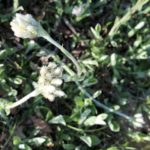
-
Pollinators like ants flock to pussytoes.
-
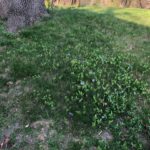
-
An excellent ground cover.
-
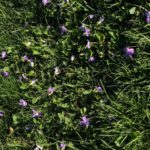
-
Pretty purple violets.
Our lawn actually is a mosaic of many plants. Since we shun herbicides we have a lawn blend of grasses, violets, dandelions, pussytoes, and many other plants. They are all fascinating and help pollinators through the seasons.
by Winding Pathways | May 10, 2017 | Birds, Flowers/Grasses, Nature, Travel/Columns
May is about the most exciting month to travel and camp out in Iowa. We took in the Driftless area of Iowa and Wisconsin where we learned more about mounds at Effigy Mounds National Monument, ate at funky Café McGregor, took in Starks and Cabelas in Prairie du Chien, and entered our favorite forest over the “Forest Road” into Yellow River State Forest.
- Note our reviews and thoughts are independent, unpaid and unsolicited.
Enjoy this photo journal of our stay.
-
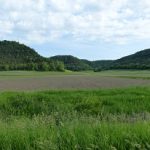
-
Fascinating terrain and vegetation characterize the Driftless Area.
-

-
More questions than answers arise when investigating mounds.
-

-
Looking Down River
-

-
A great fishing spot.
-
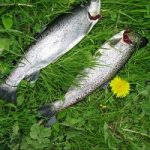
-
Fresh fish for dinner.
-
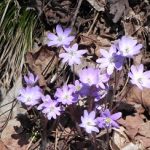
-
Spring is about a week later in northeast Iowa than central Iowa.
-
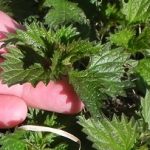
-
Nettles were a resource for Native Americans and still are for modern day foragers.
-
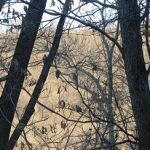
-
Last year’s young hang around as long as they can.
-
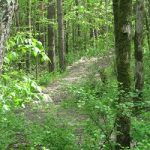
-
A favorite walk.
-

-
Season Five now open!
-
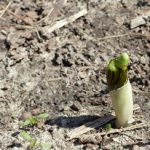
-
Tightly wrapped Mayapple pushes through the early spring ground.
-
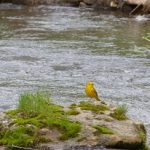
-
Birding is exceptional in May.
by Winding Pathways | May 9, 2017 | Flowers/Grasses, Nature, Trees/Shrubs, Wonderment
We invited readers of Winding Pathways blogs to submit a photo and short description of a favorite spring scene. The response spanned from the Pacific Northwest to Canada and from the Desert Southwest to New England. Enjoy readers’ reflections on our emerging spring. The essays appear as they came in to Winding Pathways. Thank you all for your charming observations. Happy Spring! And soon, welcome summer.
***
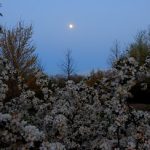
“Every year I wait for our Sargentina crab apple trees to bloom.”
As much as I love our native prairie plants and various garden inhabitants, every year I wait for our Sargentina crab apple trees to bloom. Not too long ago, in the company of one of our barn cats, I sat out on the patio and watched the full moon rise with the sweet smell of the flowers drifting over. Bees lay full claim to the blossoms during the day, from the little sweat bees to the bumbles, so I try to give them some space and wait until evening before diving nose-first into the branches myself.
Emily Groom Hemmerling, Kansas
***
Here in NH, spring is slowly unfolding. The barred owls are getting amorous and I’ve heard, although not seen, “our” hawks. There’s a barn swallow that’s building a nest under the eaves, and the bear visited the other night. The weather seems to be lacking any nuance. We are alternating between two or three days of cold, windy, rainy (tell the truth–nasty) days and occasional beautiful sunny days in the ’70s.
Waiting is hard after a long winter, but change should accelerate very soon. The hummingbirds return on average on May 11th, and by then many flowers should be in bloom and the trees that are barely budding today will be fully green. This time of year Carly Simon is often on my mind–“Anticipation”. Sue Fehsinger, New Hampshire
-
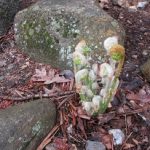
-
Unwinding slowly, fiddle head ferns appear mysteriously.
-
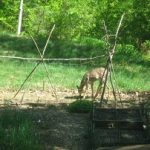
-
Deer In Garden
-
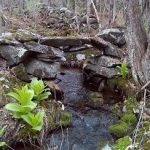
-
A New Hampshire springtime brook graced with Skunk Cabbage.
-
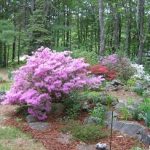
-
A splash of color!
***
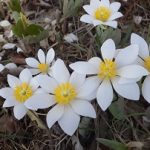
Dazzling white petal surround deep yellow centers.
These Bloodroots are found at the western end of our road. We have now lived on this road for 17 years and have watched the progression of growth and expansion each year of more and more desirable plants. The area has become a huge carpet of white under all the trees. The blossoms on the north side of the road show their faces first and a few days later the blossoms on the south side of the road appear. Since we have been here, each year it has been the same blooming schedule. We also have Bloodroots in our yard which don’t appear until the ones on the road seem to be in full bloom. They are only 1/4 mile apart.
I photographed this forsythia at the edge of our neighbor’s property. I do not have any on our property. It was a beautiful sunny day and the yellow of the blossoms was brilliant. I was also trying to get a different angle on the blossoms, rather than the whole bush.
My purple hyacinths are still producing blooms in my small north facing garden. This year they seemed to have a deeper purple color and more blossoms on the stock.
The Virginia bluebells are now blossoming. I counted 16 clumps of them in a small area at the top of our dry kettle. I am even finding small self-seeded plants.
We are privileged to see wood ducks in our channel in the early spring. They are very skittish and it is difficult to sneak up on them to get a photo. We see them for a short time and then they disappear until next year. Sue Hrobar, Wisconsin
-
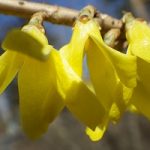
-
Like gold the flowers shine.
-
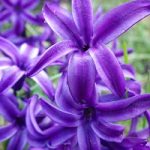
-
Beautiful Purple Blossoms
-
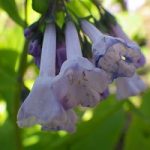
-
Close-up view
-

-
Searching for the right home.
***
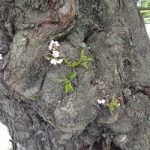
The ancient tree sprouted leaves and flowers all over.
I walked this Chestnut Hill neighborhood in Boston often while living and working in the area. My first fall a few heavily gnarled trunks of a handful of trees planted in the boulevard strips particularly captivated me. These trunks reminded me of Italian grandmothers; stout, sturdy, not particularly tall, deeply wrinkled and absolutely beautiful. When spring arrived I was amazed to see how blossoms not only appeared in their canopies but also sprang from their very bark. I loved these elderly trees all the more and saw them as clothed from head to toe in spring attire. May all of us exhibit such beauty and grace as we mature. Adria J, Illinois and Maine
***
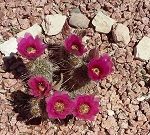
The desert Southwest alive with color.
Here is my first cactus bloom of the season! Soon my yard will be bursting with color, from all of the different cacti!
Coming from the Midwest, this is such a different sort of pretty. Most of the year it is dry and barren up here in the high desert. These little bursts of color that pop up in the spring are such a delight! I love to walk in my neighborhood and see all of the different blooms. We have a very mild winter and sometimes it’s hard to tell that spring is here, at least for this Midwestern gal. The flowers alert me that spring has indeed arrived! Such a contrast to these prickly little fellows. Add to that the brilliant green of the trees, looking almost iridescent, and the scent of the roses that pop up everywhere, I would say that spring is my
favorite season here. Deb Karpek, Arizona
***
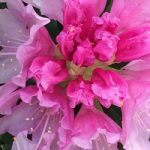
A close up of a western Rhododendron.
After the daffodils and the flowering trees fade is time in the Pacific Northwest for our native rhododendron to flower. They grow wild on the coast, but also are prized in yards because their large leaves are green all winter. Found growing wild near Port Discovery on the Washington coast in 1792 by Archibald Menzies who was with George Vancouver, it has been a favorite ever since. Officially it has been the Washington state flower since 1995, but women in 1893 designated it as such for a Worlds Fair that year. The rhododendron pictured is the Washington Centennial rhododendron from 1989. I love the way the blooms start out bright pink and fade to a pale pink as they open.
Jocelyn Berriochoa, Washington state
***
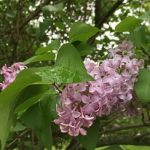
Raindrops on lilacs.
I opened the door this morning and looked out to see our lilacs blooming; pretty as could be. I thought, “Thank you, Grandma, for planting them over seventy plus years ago.” What a special way to start the day and welcome some of the beauty of spring. Claire Patterson, New Jersey
***
Spring came early to Bedford, Virginia, this year by about three weeks which means farmers, orchardists and gardeners began planting and hoping for early crops. Then to their surprise, we had two serious freezes back-to-back in March. The orchardists were especially chagrined because peaches, pears and apples took a hit. Watch for rising fruit prices.
As a gardener, it was thrilling to clean out the flowers and raised vegetable beds early on. As I began checking the asparagus patch, I noticed two silvery milkweed spears poking their heads through the soil next to the asparagus. They had begun their quiet vigil for the returning Monarch butterflies. I know the Monarchs have reached their most northern breeding grounds. However, I’ve not seen one returning Monarch here at the Ridge House.
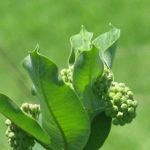
Milkweed is an important plant for Monarchs and other pollinators.
How did the milkweed come to be in my asparagus bed? There are a number of possibilities. Perhaps the birds deposited the seeds long ago. Or, the wind may have blown these wispy silky pinwheels into the patch. Another thought occurred to me that the seeds may have been tangled in the straw I scattered in the patch to help hold moisture through the dry summer months. However the seeds arrived, they are a God send as unthinking highway department mowers clear the roadsides, or a farmer applies toxic weed killer, or a home owner wanting a pristine lawn shears them off. The end result is far fewer pollinators like Monarchs and other butterflies, bees, and even birds. Where am I going with this you ask? This sage says, “All my weeds are wildflowers.” Peace. Jackie Hull, Virginia
***
-
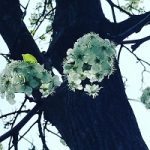
-
Spring in NYC
-

-
New York City is awash with soft color in the spring.
Spring in New York City. Dan Patterson, New York
***
Snow is melting gradually this spring. And, despite the string of rainy days lately, at the end of April we still had mounds of it around the house and in the woods.
The slow melt has meant that I’ve kept up with yard cleanup and, while trimming around the edge of the yard, I have come across early gems, like the bright purple crocuses with their eye-popping yellow-orange stamen, nestled among moss covered rocks near the path into the woods.
Elsewhere, along the edge of the woods, the early Spring ground cover, known as ‘William & Mary’, is starting to show its pink and blue blossoms. (I think of my patch as ‘Will & Kate’.)
And, I uncovered the little pile of beach stones that granddaughter Cadence assembled one summer.
Every Spring is different and every day brings different discoveries and possibilities in the garden.
Now, I’m headed out and about to see what new stuff is uncovered before the heavy rains come. I’m thankful we live outside the flood zone, but Fredericton will see another 100 year flood this weekend I fear. Lucy Fellows, New Brunswick, Canada
-
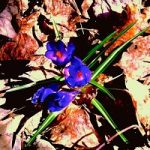
-
Poking through the leaves is a burst of color.
-
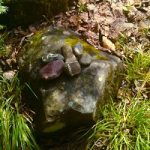
-
A stack of pebbles.
-
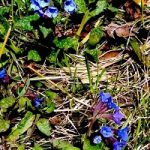
-
Early spring arrival













































